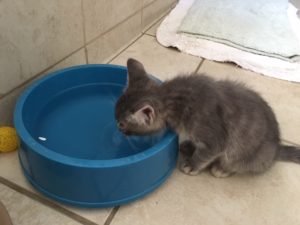 What do you feed your cat in? A tray left from last night’s frozen meal, a paper plate, a saucer from your grandmother’s favorite China set, or a cute designer cat food bowl? You might be surprised that it does matter how you feed your cat.
What do you feed your cat in? A tray left from last night’s frozen meal, a paper plate, a saucer from your grandmother’s favorite China set, or a cute designer cat food bowl? You might be surprised that it does matter how you feed your cat.
I had to chuckle when I wrote that last sentence because we have to use a strategy to feed around here. We just have the two cats now—but Lily is on a special diet and lusts after Sophie’s food. She will eat her food, but not if Sophie’s food is within sniffing range. If Lily happens to approach Sophie’s dish, Sophie will stop eating and leave. She won’t fight for the right to eat. I don’t know how she survived for 10 weeks on the streets. Lily has no problem sharing her meals, but Sophie is too sophisticated to try taking food from Lily. So here, we have to get Lily situated with her meal first—out of sight of Sophie. Then we watch Lily to make sure she doesn’t decide that the grass is greener around the corner.
Believe it or not, I can actually lure Lily back to her meal when she wanders, if I get down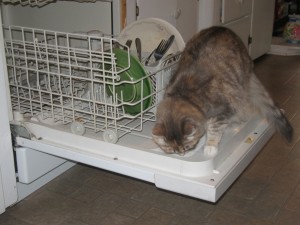 on the floor and pretend I’m going to eat with her. She loves an audience, even when eating. (The things we do for our cats!)
on the floor and pretend I’m going to eat with her. She loves an audience, even when eating. (The things we do for our cats!)
Ever hear of whisker stress? We discussed it here once. Some cats are particularly sensitive to having their whiskers rub on the sides of a bowl while they’re eating or drinking. Flat surface plates or shallow bowls are more comfortable for cats to eat and drink out of.
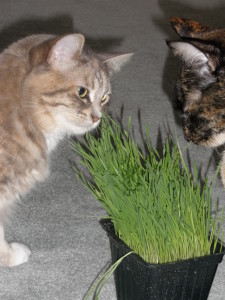 Some cats get chin acne from plastic bowls. We had this happen to one of our cats. We switched from plastic to metal and pottery and his feline acne cleared up. After further study on this issue, they now believe that it isn’t the plastic that creates the acne problem for cats, it’s the fact that plastic can’t always be cleaned as thoroughly as other types of eating vessels and the bacteria left on the plastic surface is actually the culprit, not the material.
Some cats get chin acne from plastic bowls. We had this happen to one of our cats. We switched from plastic to metal and pottery and his feline acne cleared up. After further study on this issue, they now believe that it isn’t the plastic that creates the acne problem for cats, it’s the fact that plastic can’t always be cleaned as thoroughly as other types of eating vessels and the bacteria left on the plastic surface is actually the culprit, not the material.
A few years ago, I got tired of washing and re-washing the saucers I was using to feed the cats on, so I went shopping at a thrift store. I bought ten more saucers. I no longer had to wash the saucers after just a few meals. I could simply scrape and rinse the saucers and put them in the dishwasher. I had enough to last for several days. After visiting a cat café, however, and watching the host feed their array of cats using cardboard food trays—such as you would get when ordering a hotdog or French fries—I’ve started using these. You can buy them in bulk at big box stores. I ordered some online. So far that’s working for us.
However, then the question is raised: which way of feeding is more beneficial to the 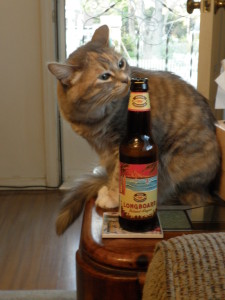 environment? How do you weigh the amount of water used in cleaning dishes against the waste entering landfills when using paper products?
environment? How do you weigh the amount of water used in cleaning dishes against the waste entering landfills when using paper products?
How do you feed your cat? If he’s a flat-face Persian, he might require a wide, shallow bowl. A munchkin would have trouble eating from a deep bowl, too. We had a cat with an enlarged heart. When he started having issues, our veterinarian suggested elevating his food and water bowls. So we placed Max’s meals on a six-inch high stool so he was more comfortable while eating. This big-hearted guy lived to be well over seventeen years old.
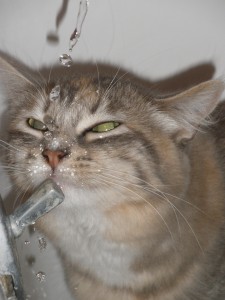 One benefit of using paper products in which to feed your cat is for sanitary reasons. I think we’ve all seen horribly crusted-over feeding dishes in industrial districts where feral cats are being fed and in backyards where the resident cats run free. Sometimes the ants beat the cats to the meal. Not very appealing or sanitary. Whatever type of feeding container you and your cat decide upon, make sure it is clean at each feeding. Feed freshly opened cat food or food that’s been kept in the refrigerator for not more than a day. Always provide one (preferably more) bowl of fresh, clean water. Keep in mind that if the water is outside or if you have a pet door to your house or garage, wild animals and other neighborhood pets could be eating and drinking from your cats’ plates. When this happens, the remaining food and water could be contaminated.
One benefit of using paper products in which to feed your cat is for sanitary reasons. I think we’ve all seen horribly crusted-over feeding dishes in industrial districts where feral cats are being fed and in backyards where the resident cats run free. Sometimes the ants beat the cats to the meal. Not very appealing or sanitary. Whatever type of feeding container you and your cat decide upon, make sure it is clean at each feeding. Feed freshly opened cat food or food that’s been kept in the refrigerator for not more than a day. Always provide one (preferably more) bowl of fresh, clean water. Keep in mind that if the water is outside or if you have a pet door to your house or garage, wild animals and other neighborhood pets could be eating and drinking from your cats’ plates. When this happens, the remaining food and water could be contaminated.
If your cat isn’t eating as much or as eagerly as you think she should or if she seems to struggle at mealtime, consider the issues we touched on here and try to remedy the problem with, perhaps, a different type of vessel for her food and/or water.



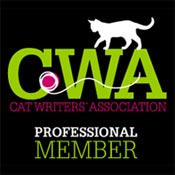
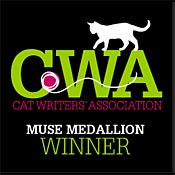

We have the same problem here. One cat overweight and hating her “diet” food and the other one with high thyroid levels and needing to eat to maintain weight and no backbone to fend the other one off. Therefore, I feed in separate rooms and close the door on the timid cat. I hate that because she is a slow eater and misses time with us, but it’s the only way I can handle the situation.
We do what we have to do, don’t we? And I know what you mean about hating to isolate a cat or feed them something when they’d rather have what the other cat has. What about isolating the more confident cat and letting the timid cat eat near you? It’s strange, but Lily–the one with the kidney disease–will leave her food sometimes we think too soon. So I’ll crouch near her food and try to sweetly lure her back and she’ll return and eat more as long as I sit there with her. Sophie is more timid and needs everything to be quiet and calm when she eats, so we make sure everyone in the house is seated and still before we put her food down. If the phone rings, we get up for anything, someone walks into the room, Sophie bolts and won’t finish her meal. I wish you continued success with your kitties. And thanks for following this blog.